El surf y el remo van de la mano, como una máquina bien engrasada que impulsa tus aventuras sobre las olas. Sin embargo, lo que te mantiene en el agua la mayor parte del tiempo es remar. Si eres nuevo en el surf y todavía estás averiguando cómo remar cómodamente, o si eres un surfista experimentado pero te cansas rápidamente durante las salidas remando, estás en el lugar correcto.
A medida que te embarcas en tu remando en el surf Si estás en busca de un viaje, considera a esta guía como un amigo de confianza. Desde la selección del equipo adecuado hasta el perfeccionamiento de tus brazadas, estamos aquí para dejarlo todo muy claro. ¡Súmate a este viaje y surfeemos juntos las olas con confianza!
¿Cómo remar en una tabla de surf ?
Remar de manera eficiente es el alma de tu experiencia de surf. Es lo que te mantiene conectado con las olas y te impulsa hacia esos emocionantes viajes. En esta sección, desglosaremos los pasos para remar en una tabla de surf:
1. Comience con un calentamiento completo
La práctica del remo exige un esfuerzo físico, por lo que es importante realizar un calentamiento adecuado. Puedes hacerlo en la playa o antes de salir del campamento de surf. Remando en el surf involucra principalmente los hombros y la parte superior de la espalda, así que concentra tu calentamiento en activar estas áreas.
Además, ten en cuenta que mientras remas, te sientas en la fila y surfeas olas, tus caderas permanecen en una posición fija. Para garantizar la flexibilidad y la comodidad a largo plazo, incluye ejercicios y estiramientos en tu calentamiento que ayuden a abrir las caderas.
2. Elige la tabla de surf adecuada
Al iniciarse en el surf, el tipo de tabla que se utiliza tiene un gran impacto, especialmente para los principiantes. Las tablas de mayor tamaño (es decir, más largas, más anchas y con más espacio) suelen ser la opción preferida por los surfistas noveles. Por el contrario, quienes llevan más tiempo surfeando tienden a cambiar a tablas más pequeñas.
Piensa también en tu tamaño. Si eres más corpulento, es posible que necesites una tabla más grande para mantener el equilibrio, mientras que los surfistas más pequeños pueden optar por tablas más pequeñas.
Ten en cuenta también el tipo de olas que vas a surfear: las olas más lentas son adecuadas para tablas largas y las más rápidas para tablas cortas. No tengas miedo de pedir consejo a surfistas experimentados o a tiendas de surf, incluso puedes probar distintas tablas para ver cuál te parece más adecuada. Investigar un poco sobre distintas marcas y tipos de tablas también puede ser de ayuda.
3. Colócate correctamente sobre la tabla de surf
Para mejorar en Para remar en el surf , debes encontrar la posición correcta en tu tabla. Túmbate justo en el medio de la tabla, levanta un poco el pecho y mantén la barbilla hacia abajo. Tus pies deben estar juntos, con los dedos de los pies apuntando hacia abajo. Coloca las manos cerca del pecho a los lados de la tabla, manteniendo los codos doblados en un ángulo agradable de 90 grados. Asegúrate de no inclinarte demasiado hacia adelante o hacia atrás, ya que esto puede hacerte más lento y perder estabilidad mientras remas.
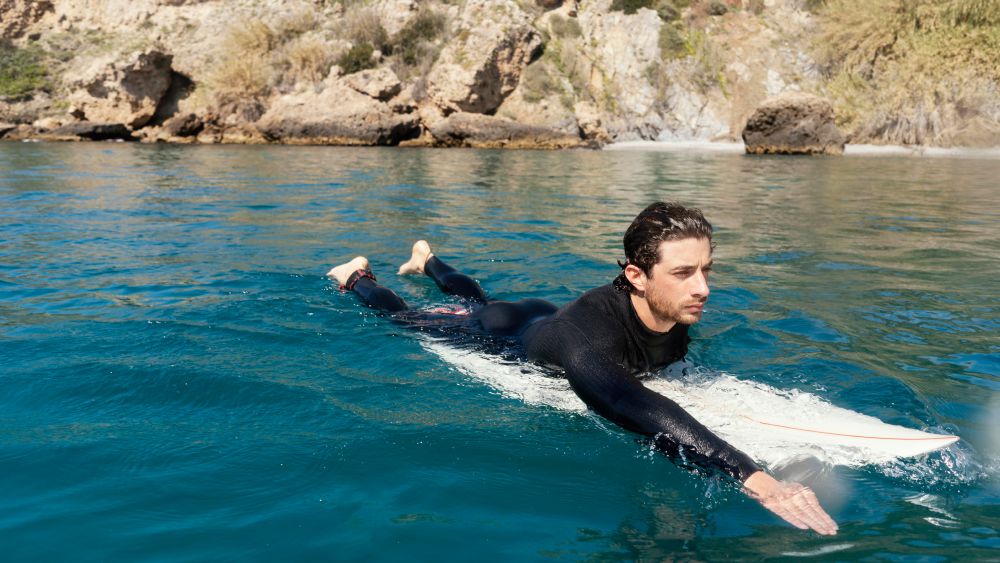
4. Utiliza la técnica de remada correcta en el surf
Para remar bien hay que utilizar la técnica adecuada. Las paladas deben ser suaves, profundas y potentes.
No utilices solo el antebrazo, sino todo el brazo, desde el hombro hasta la muñeca. Activa los músculos de la espalda y del torso, no solo los brazos. Mantén un movimiento circular al remar, entrando al agua cerca de la nariz y saliendo cerca de la cadera. Evita salpicar, dar palmadas o hundirte en el agua, ya que estas acciones desperdician energía y te hacen perder velocidad.
¿Estás listo para remar con más fuerza y surfear mejor? Sumérgete en nuestra última publicación del blog para obtener información esencial ejercicios para hacer surf con remo Que mejorará tu juego de surf.
5. Mantenga la cabeza y el cuerpo quietos
Para remar con precisión, mantén la cabeza y el cuerpo alineados con la dirección de la tabla de surf. El movimiento excesivo de la cabeza de un lado a otro altera el equilibrio y la visión. Asimismo, evita torcer el cuerpo o levantar las caderas, ya que esto crea una resistencia e inestabilidad innecesarias. Mira hacia arriba solo cuando necesites comprobar si se acercan olas o evaluar la alineación.

6. Respirar adecuadamente
Ahora, exploremos el siguiente elemento del éxito. Surfista remando – Respiración adecuada. Para remar de forma eficaz, recuerda respirar profundamente, de forma rítmica y tranquila. Inhala por la nariz y exhala por la boca. Evita contener la respiración, jadear o jadear, ya que estas acciones aumentan tu frecuencia cardíaca y provocan fatiga. Además, evita tragar agua, ya que puede provocar atragantamiento y tos. Sincroniza tu respiración con las brazadas y exhala cuando tu mano salga del agua.
7. Calcula el tiempo que tardas en remar
El siguiente paso en el viaje hacia la maestría Surfista remando El objetivo es perfeccionar el ritmo. Mantenga un ritmo constante y constante al remar, evite ir demasiado rápido o demasiado lento. Adapte la velocidad de la remada a las condiciones de la ola y a su posición. Aumente la velocidad de las paladas cuando sea el momento de atrapar una ola, escapar de una corriente de resaca o esquivar obstáculos. Por el contrario, reme más despacio para conservar energía, descansar o esperar pacientemente la ola perfecta.
8. Inclina tu tabla de surf
Cuando estas En el paddle surf , la inclinación de la tabla de surf marca una gran diferencia. En lugar de apuntar directamente a la ola, inclínate ligeramente hacia un lado. Este enfoque te ayuda a evitar la zona de impacto, donde rompen las olas, y te posiciona hacia el hombro, donde las olas se forman con más suavidad. Una tabla de surf bien inclinada ayuda a atrapar la ola en su punto óptimo, donde es más empinada y se mueve más rápido. Para inclinarla de manera efectiva, desplaza tu peso un poco hacia un lado y rema más hacia el otro.
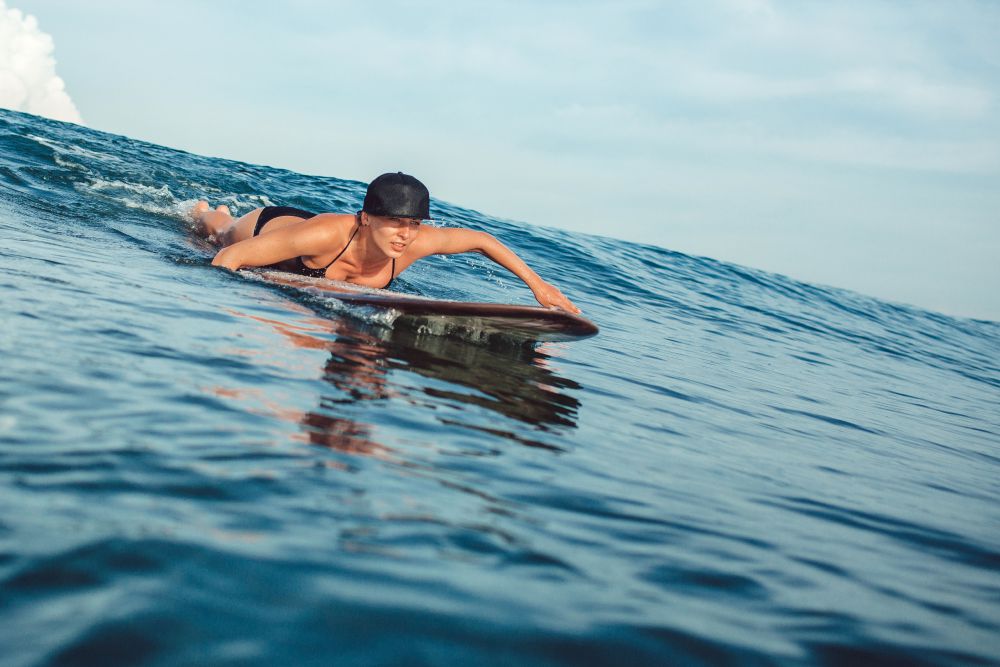
9. Buceo de pato o voltereta de tortuga
En El paddle surf es una técnica que implica hacer un salto de pato o un giro de tortuga. El salto de pato, ideal para tablas de surf más cortas, consiste en sumergirse a uno mismo y a la tabla bajo una ola entrante y volver a la superficie por el otro lado. El giro de tortuga, más eficaz para tablas largas, requiere que uno mismo y la tabla se den la vuelta bajo el agua, permitiendo que la ola pase por encima antes de volver a la posición inicial. Aprender estas técnicas es esencial para una experiencia fluida y eficaz en el paddle surf.
10. Aparece rápidamente y sin problemas
Cuando se trata de remo de tabla de surf Técnicas: los surfistas deben ser perfectos en el suave pop-up. Este movimiento es cuando pasas de estar acostado sobre tu tabla de surf a estar de pie sin problemas. El tiempo lo es todo aquí: quieres emerger justo cuando sientes que la ola te impulsa hacia adelante, ni demasiado pronto ni demasiado tarde. Hazlo con un solo movimiento fluido, evitando cualquier proceso de dos pasos. Comienza colocando tus manos cerca de tu pecho sobre la tabla de surf y empújate hacia arriba. Luego, lleva tus pies debajo de ti, parándote en una posición equilibrada y estable.
11. Rema de regreso a la alineación
En tu viaje para aprender Cómo hacer paddle surf : debes saber cómo regresar a la línea de posición, donde se están formando las olas. Ya sea que hayas surfeado una ola o hayas sufrido una caída, debes regresar de manera rápida y segura. No pierdas tiempo ni energía. Rema de regreso siguiendo los mismos pasos que usaste antes, pero en orden inverso. Mantente atento a otros surfistas, observa las olas y ten en cuenta las corrientes de resaca para evitar problemas.
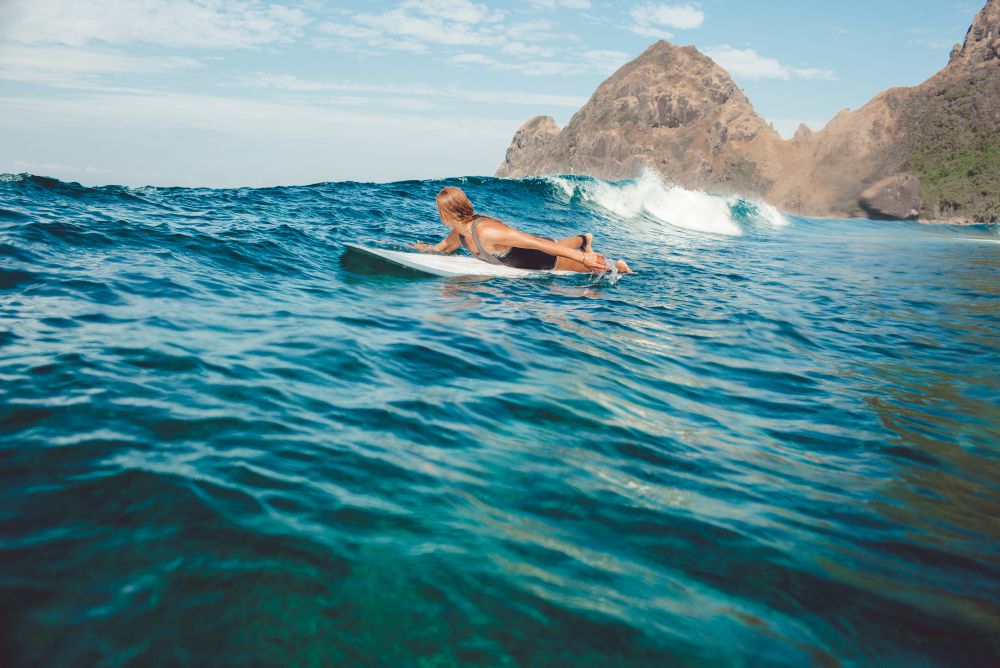
12. Rema para salir del camino
En Al remar en el surf , la seguridad es una prioridad máxima, y eso significa saber cuándo salir del camino. Si ves una ola u otro surfista que se acerca hacia ti, actúa rápido y apártate rápidamente. La mejor acción es dirigirse hacia el agua blanca, donde la ola ya ha roto, en lugar de remar hacia la zona de agua verde sin romper. Además, asegúrate de avisarles a los demás surfistas lo que estás haciendo señalando tu dirección y no dudes en disculparte si estás en el camino de alguien.
13. Remar a un ritmo normal
Intentar remar demasiado rápido, como en un sprint, solo te agotará antes de llegar a la línea de meta. En lugar de eso, concéntrate en realizar brazadas largas, suaves y constantes. Este enfoque te ayudará a moverte con rapidez y eficiencia por el agua.
14. Sea consciente del seguimiento de su accidente cerebrovascular
Durante la fase de "tracción" de la remada, no extiendas las manos demasiado hacia atrás. Si estiras demasiado los brazos, puedes ir más lento. La forma correcta es llevar los brazos hacia atrás hasta el nivel del pecho y luego sacarlos del agua para la siguiente remada. Si te pasas de ese punto, la tabla puede inclinarse y perder velocidad.
15. Técnica de arrastre del pulgar al remar
En Al remar en el surf , un consejo útil es arrastrar, o casi arrastrar, los pulgares a través del agua mientras llevas las manos hacia adelante en cada brazada. La técnica va de la mano con mantener los codos elevados, lo que naturalmente coloca las manos más abajo. Puedes evitar levantar las manos demasiado fuera del agua de esta manera, lo que ahorra energía al no trabajar demasiado los músculos de la parte superior de la espalda.
16. Posicionamiento de piernas y pies
Resista la tentación de patear con los pies mientras Remar en el surf : al contrario de lo que se pueda pensar, dar patadas puede reducir la velocidad. Para lograr la mejor condición de remar, mantenga los pies juntos y alinee los tobillos. Al dar patadas, el peso se desplaza demasiado hacia adelante, por lo que una posición quieta de los pies garantiza un mejor equilibrio y velocidad.
17. Cómo usar la columna vertebral de manera eficaz al remar en el surf
Tu columna vertebral es un polo central que ayuda a equilibrar tu cuerpo cuando estás Remar en el surf . Al remar, el cuerpo se balanceará naturalmente de un lado a otro con cada brazada, de forma similar a lo que ocurre al nadar. Este movimiento se produce cuando estiras los brazos para remar. Para hacerlo bien, imagina una línea recta que recorra tu cuerpo desde la cabeza hasta el coxis. Además, debes mantener la cabeza firme mientras mueves los brazos en cada brazada.
¿Cómo perfeccionar tus técnicas de remada en el surf ?
Ahora que hemos cubierto los conceptos básicos de Remar en el surf : ahora vamos a perfeccionar tus habilidades. Aquí tienes algunos consejos sobre cómo perfeccionar tus técnicas de remar para disfrutar de una experiencia de surf aún mejor.
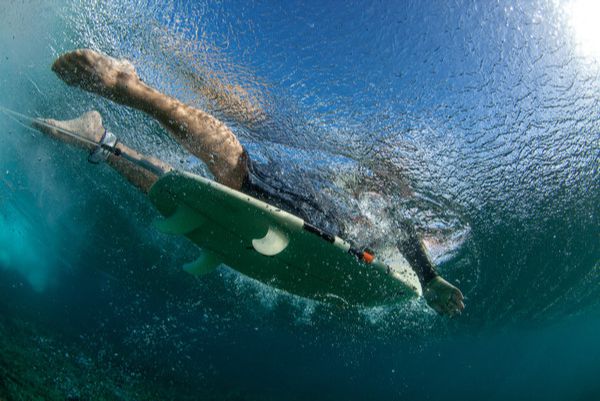
1. Reducción de la resistencia al remar
Para lograr una remada eficiente es necesario reducir la resistencia del agua o "arrastre". Para ello es necesario encontrar la posición perfecta en la tabla de surf, conocida como "punto dulce", en la que te alineas correctamente tanto vertical como horizontalmente. Esta alineación garantiza una resistencia mínima a medida que te mueves por el agua, y es esencial estar centrado y equilibrado en la tabla para una remada óptima.
- Posición vertical del cuerpo al remar
Para lograr una correcta alineación vertical, es necesario asegurarse de que la tabla de surf esté plana en el agua, arquear la espalda ligeramente y mantener la punta de la tabla justo por encima de la superficie. La cabeza debe estar erguida, los ojos mirando hacia adelante y las piernas juntas. Dos errores comunes que se deben evitar son reclinarse demasiado hacia atrás, levantar demasiado la punta e inclinarse demasiado hacia adelante, lo que sumerge la punta.
- Posición horizontal del cuerpo al remar
Mantenerse centrado y equilibrado horizontalmente es crucial. Una buena forma de comprobarlo es sacar las manos del agua al mismo tiempo. Si te inclinas hacia un lado, es necesario ajustar tu posición. Levantar la cabeza, que pesa unos 20 kg, puede levantar significativamente la punta de la tabla. El "punto óptimo" es donde la tabla queda tan plana que los pequeños cambios en tu posición provocan movimientos notables en la punta.
- Consejos para remar según la posición del cuerpo
Imagina sostener un balón de fútbol debajo de tu barbilla para mantener la cabeza en la posición correcta, manteniendo la espalda arqueada y minimizando la resistencia. Además, mantener los pies juntos ayuda a mantener una posición horizontal. Evita usar las piernas para estabilizarte cuando no estés centrado, ya que esto puede hacer que vayas más lento y generes más resistencia.
- Técnica de palada
Además de la posición, las paladas en sí son fundamentales. Entra al agua con las puntas de los dedos primero, evitando salpicar para reducir la resistencia. Intenta realizar paladas silenciosas, suaves y potentes. Mantén la cabeza firme para minimizar la resistencia y mantener la estabilidad.

2. Mejorar la propulsión al remar
Maximizar la propulsión consiste en mover el agua hacia atrás de manera eficiente para impulsarse hacia adelante. Puedes lograrlo dominando el movimiento de remada adecuado, que se puede dividir en cuatro fases:
- La fase de captura
Comience con la mano entrando en el agua y extendiendo el brazo. El objetivo es maximizar el área de la superficie, empujando el agua hacia atrás. Imagínese abrazando un tronco imaginario, logrando una posición de "antebrazo vertical temprano" (EVF) con el codo alto y las puntas de los dedos apuntando hacia abajo.
- La fase de tracción
Concéntrese en tirar del agua hacia atrás para acelerar. Mantenga la mano y el antebrazo alineados y perpendiculares al fondo marino, con el codo elevado. Evite doblar la muñeca o bloquear el hombro, ya que esto reduce la eficacia del tirón.
- La fase de recuperación
Después de tirar, saca el brazo del agua suavemente, guiándolo con el codo. Este movimiento debe sentirse sin esfuerzo, con la mano siguiendo el codo fuera del agua.
- La fase de entrada de la mano
La mano debe volver a entrar en el agua por delante de la cabeza y el hombro, alineada con el borde de la tabla de surf. Asegúrate de que las puntas de los dedos entren primero para reducir la resistencia, con la muñeca más alta que las puntas de los dedos y el codo más alto que la muñeca.
Consejos prácticos para maximizar la propulsión
- Mantenga el codo alto en los momentos clave durante su brazada.
- Pruebe el ejercicio del puño, remando con los puños para concentrarse en el uso del antebrazo.
- Siente la resistencia en tu mano y antebrazo; debes sentir como si te estuvieras impulsando hacia adelante al empujar el agua hacia atrás.
Ahora que sabes cómo remar en una tabla de surf, quizás te preguntes cómo perfeccionar tu remando en el surf Técnicas. A continuación, se ofrecen algunos consejos y trucos que le ayudarán a mejorar sus habilidades y su rendimiento al remar:
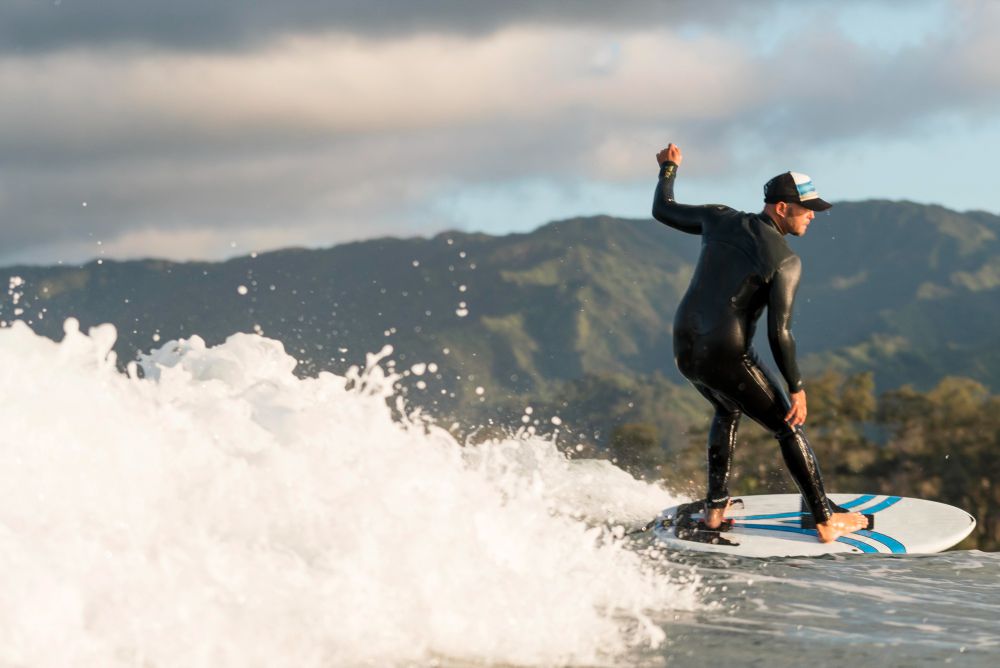
Elige Boost Fin para atrapar más olas
¿Estás listo para llevar tu surf al siguiente nivel? La aleta Boost está aquí para que eso suceda. Es un complemento increíble que se conecta a cualquier tabla en aproximadamente 5 minutos. A continuación, se incluye un breve resumen de por qué la aleta Boost es un accesorio imprescindible para los surfistas:
- Empuje potente: La aleta Boost Fin tiene una potencia de empuje de 20 libras, similar a la potencia de 15 remeros en una canoa.
- Mayor velocidad para atrapar olas: La aleta Boost puede aumentar tu velocidad hasta 10 mph, lo que hace que sea más fácil y rápido atrapar esas olas perfectas.
- Batería de larga duración: Disfruta de sesiones de surf más prolongadas gracias a la batería de Boost Fin, que dura entre 60 y 90 minutos con una sola carga.
Especificaciones rápidas:
- Ligero: Pesa tan solo 2,7 libras, por lo que tu tabla no resultará pesada.
- Material duradero: Fabricado con polímero reforzado con fibra de vidrio y plástico ABS para mayor durabilidad.
- Batería de alta calidad: Una batería de iones de litio de 3500 mAh, 24 V y 84 Wh garantiza un uso prolongado.
- Control remoto eficiente: Viene con un control remoto de 433 MHz para una respuesta inmediata.
Boost Fin es una forma asequible de mejorar tu tabla de surf. Mientras que otras aletas eléctricas pueden costar hasta $1,000, Boost Fin cuesta solo $499. Es una forma resistente, rápida y rentable de hacer que tus sesiones de surf sean más emocionantes.
Transforma tu experiencia de surf con Boost Fin
Remar tiene un impacto significativo en la forma en que atrapas las olas, en tu rendimiento general al surfear y en el disfrute que obtienes del deporte. Sin mencionar que remar de manera eficaz también contribuye a tu salud física y bienestar mental.
Para mejores habilidades en Para remar en el surf , comience haciendo un calentamiento adecuado y concéntrese en encontrar la posición más cómoda en su tabla. Los siguientes pasos implican practicar las técnicas de remada correctas, asegurándose de que sus paladas estén bien sincronizadas y que su tabla esté colocada correctamente para las olas. A medida que progrese, concéntrese en técnicas avanzadas como reducir la resistencia del agua, mejorar su deslizamiento en el agua, fortalecer los músculos de remada y refinar continuamente su técnica para una mayor eficiencia.
Aleta de refuerzo Está diseñado para ayudarte a remar de manera más efectiva, brindándote la potencia y la velocidad para atrapar ola tras ola con facilidad. ¿Por qué esperar? Mejora tu nivel de surf con la aleta Boost.


Compartir:
Etiqueta del surf: reglas básicas del surf
¿Cómo generar velocidad de surf en una tabla de surf?